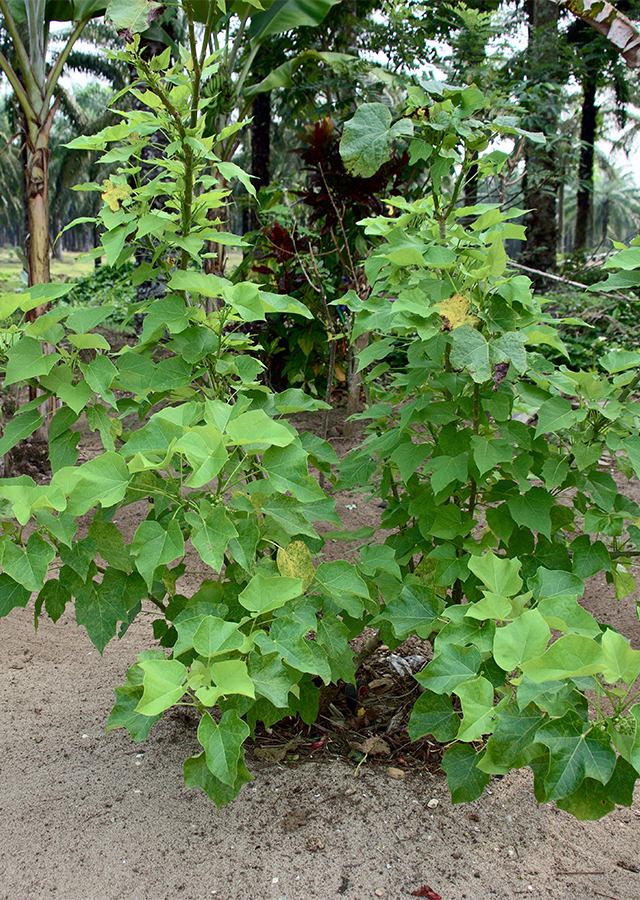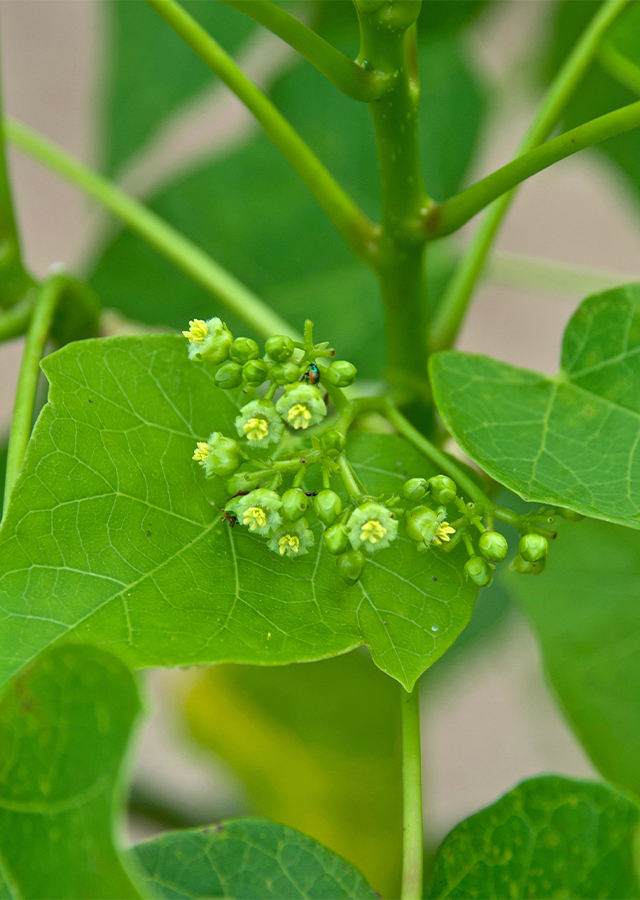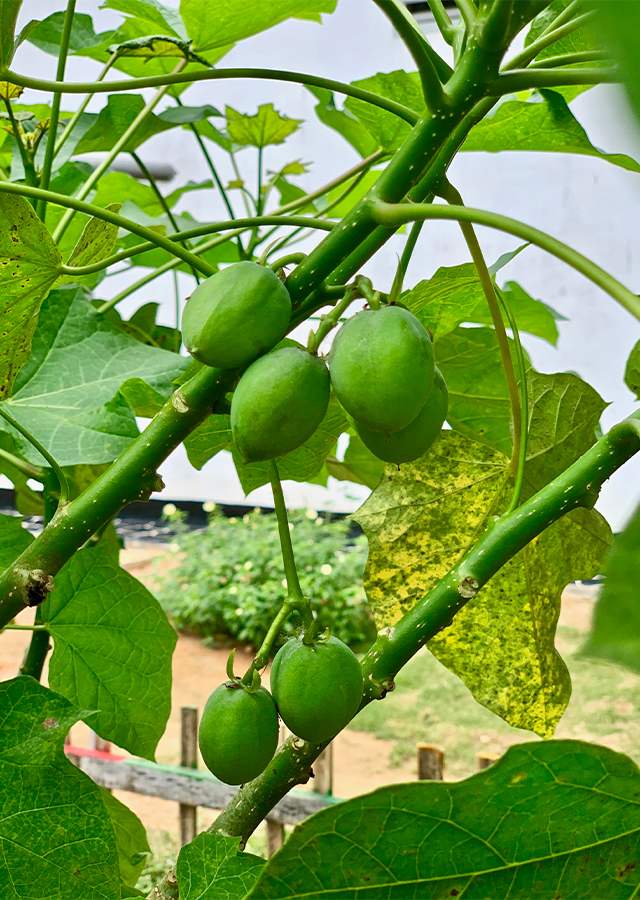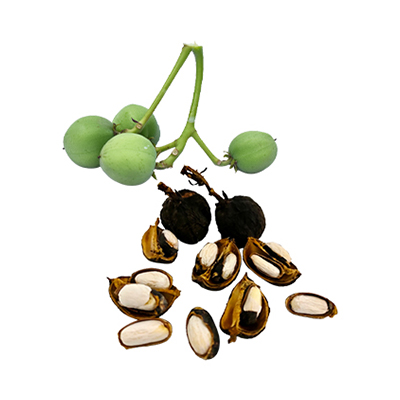Purging Nut
Jatropha curcas L.
Euphorbiaceae
Location in our garden
Principal



Synonym
Curcas adansonii Endl.
Curcas curcas (L.) Britton & Millsp.
Curcas drastica Mart.
Habitus
Shrubs. Woody shrub, perennial, up to 6 m tall
Part Used
Leaves
Seeds
Bark
Latex
Stem
Growing Requirements
Full Sunshine
Need Shade
Drought Resistant
Habitat
Forest
Coastal
Roadside
Shrublands
Grassland
Overview
It probably originated from Mexico and Central America. This succulent shrub or small three with pink latex is extensively cultivated in the tropics as a medicinal plant, living fence, biofuel crop and for the oil obtained from its seed.
Vernacular Names
Purgeernoot (Dutch), Kesugi (Myanmar), Fava purgatrice (Italian), Tubang-bakod (Tagalog-Philippines), Dandebarri (Arabic), Ma fong chou (Chinese), Adalai (India), jarak belanda, jarak keling, jarak pagar (Malay), jarak kosta, jarak pagar (Indonesia).
Agroecology
The average annual precipitation of provenance from 520-2,000 mm. temperatures range from 11-28 °C. It prefers full sun or light, part-day shade. It grows on well drained soils with good aeration and is well adapted to marginal soils with low nutrient content. Soil pH range is 5.5-7.5.
Morphology
- Roots - tuberous.
- Stem – bark smooth, shiny, greenish-brown or yellowish-grey, peeling off in papery scales, with pink watery sap.
- Leaves – leaf blade broadly, ovate in outline, usually shallowly 5 lobes or occasionally not lobed, shallowly to deeply cordate at base, sparsely puberulous along the veins below at first, otherwise glabrous, petiole 10-15 cm long, glabrous.
- Flowers – inflorescence subcorymbose, peduncle up to 5(- 7) cm long; male flowers with ovate calyx lobes about 2 mm long, petals fused in lower half, about 3 rom long, greenish-yellow, stamens 10, in two whorls of 5; female flowers with about 4 mm long calyx lobes, petals about 6 mm long, staminodes present, stigmas bifid. The female flower open one or two days before the male ones or at the same time as the earlier t male. Male flowers last only one day. The sweet, heavy perfume at night and greenish-yellow flower show that this pecies is pollinated by moths.
- Fruits – 3-lobed fleshy capsule, broadly ellipsoid, 2.5- 3 cm x 2 cm.
- Seeds - ellipsoidal, 1.5-2 cm, black, with minute caruncle. Seeds are oily and innate (primary) dormancy.
Cultivation
- J. curcas propagation is by seed and stem cutting. Fresh seed is soaked over night to improve germination. Germination takes 10 days. Stem cutting 30 cm long starts producing seed 4-5 months after planting. Plants from cuttings are more short-lived and less drought- and di ease-resistant than those raised from seed. It is well-adapted to arid and semi-arid conditions and generally occur in seasonally dry areas.
Chemical Constituents
- Leaves: kaemphesterol compounds, sitosterols, stigmasterol, amirin and teraksrol.
- Seeds: β-glukanase, toksalbumin and curcin.
- Sap: flavonoids, saponins, jatrophone.
- Stems: tannins and resins.
- Fatty acid in seed are palmitic acid, stearic acid, oleic acid and linoleic acid. The toxic principles of the oil have been identified as esters of the diterpene 12-deoxy-16-hydroxyphorbol or phorbol esters and from protein fraction named as “curcain”.
Traditional Medicinal Uses
Medicinal Uses
- Leaves are used to treat scabies, wound and as a rubefacient for paralysis and rheumatism.
- Seed oil is toxic to human and animal. It is used as insectisidal, antelmintic and abortifacient.
- The latex was used externally for healing wound, and in the treatment of various skin problem (eczema and dermatomycosis).
Traditional Uses
J. curcas is widely cultivated in the tropics as a living fence or ornamental. The seed oil is used for the manufacture of candles and soap, for lamp and motor oil and as fuel for cooking. It also can be used as fish poison.
Part Used
Reference Sources
- CABI. (2015). Invasive Species Compendium. Jatropha curcas (jatropha). https://www.cabi.org/isc/datasheet/28393. 02-02-2021.
- Fern, Ken. (2014). Useful Tropical Plants. Jatropha curcas. http://tropical.theferns.info/viewtropical.php?id=Jatropha+curcas. 02-02-2021.
- Ling, K.H., Kian, C.T., & Hoon, T.C. (2009). A Guide to Medicinal Plants: An Illustrated, Scientific and Medicinal Approach. World Scientific Publishing Co.Pte.Ltd., Singapore 81-82.
- StuartXchange. (2016). Philippine Medicinal Plants. Tubang-bakod. http://www.stuartxchange.org/TubangBakod.html 02-02-2021.
- Susiarti S, Munawaroh E and Horsten SFAJ. 1999. Jatropha L. In: de Padua, L.S. Bunyapraphatsara, N. and Lemmens, R.H.M.J. (Editor ): Plant Resources of South-East Asia 12(1). Medicinal and poisonous plants 1. Backhuys Publishers, Leiden, the Netherlands. p. 321-327.



